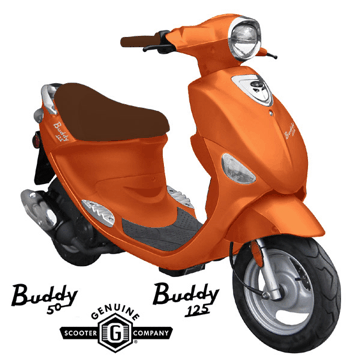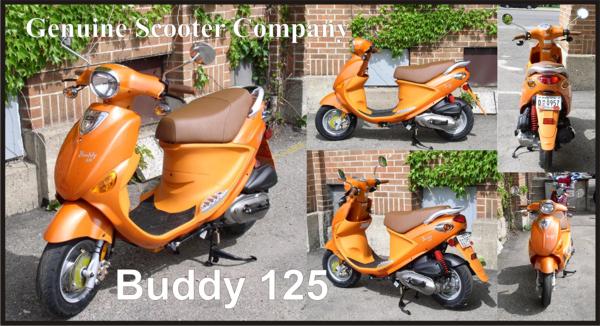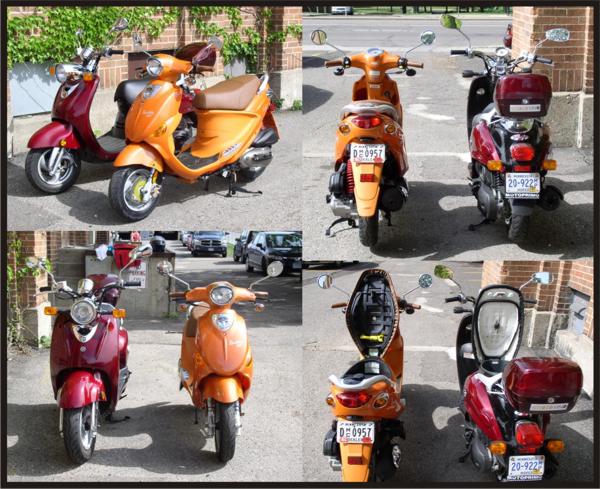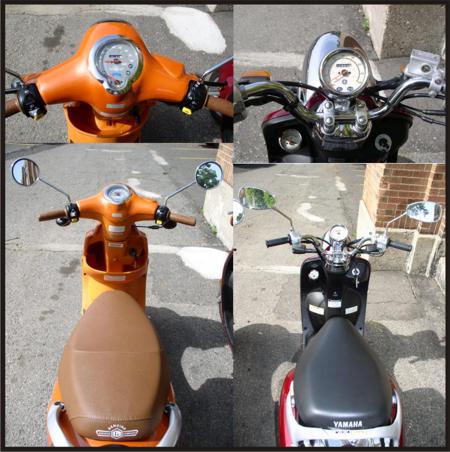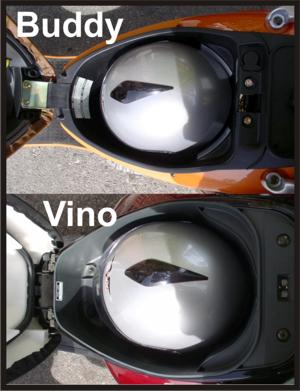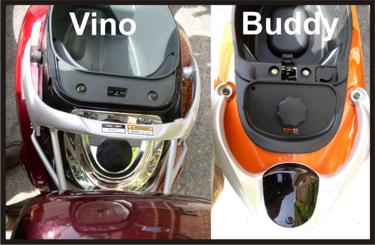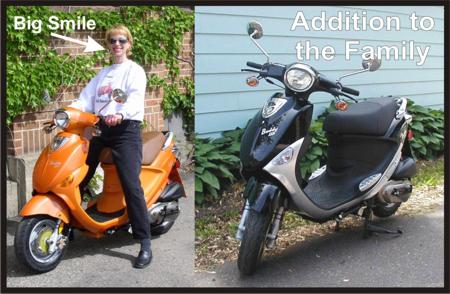We all love The Stella…. we do all love The Stella, don’t we? Hmmm, my wife could have had a Stella, and she picked a Vino instead, my friend Camille went with a Venice, OK – maybe there really are “other” scooters in the world aside from The Stella.
Apparently Phil at Genuine realized this (long before I did) and has expanded his offerings with some high quality automatic scooters (see also The Black Cat) According Bob at Scooterville, the Buddy is a lower seat height than The Stella – which should make for a better fit in the under-31-inch-inseam crowd. The Buddy is being offered in a 50cc 2-stroke version with a price of about $1,900 and a 125cc 4-stroke version for about $2,500.
Click on the image above or CLICK HERE to get more info.
Review of the Buddy 125
UPDATE
June,2009
The Genuine Buddy 125cc now has an MSRP of $2,699. It has a two-year warranty and two-year roadside assistance. It is available in black, red, orange, seafoam green, light blue & white.
OK, I need to get this out of my system…. to me…. “Buddy” brings visions of The Skipper and Gilligan. I’m sorry,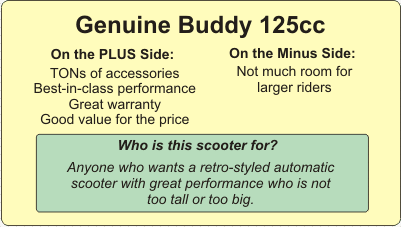
The Buddy is marketed by Genuine Scooter Company of Chicago Illinois, the brain-child of Philip McCaleb. Philip started Scooterworks USA in 1989 and that company quickly became THE source for scooter parts and service. Around Christmas of 2002, he announced Genuine Scooter Company and the Stella scooter. Both Scooterworks USA and Genuine Scooter Company have been resounding successes and an absolute boon to the US scootering market. The metal-bodied 2-stroke Stella is a wonderful scooter (I own a red 2005) and Genuine Scooter Company has built up quite a fan base. The introduction of the Buddy adds a “new school” automatic scooter to compliment the established “old school” manual shift Stella line. If the history of the Stella is any indication, we can expect a fine assortment of accessories for the Buddy. The Buddy is manufactured in Taiwan by PGO. Founded in 1964, PGO manufactured components for Piaggio from 1972 to 1982 and has won numerous quality awards.
Throughout this review I will compare the Buddy to the Yamaha Vino. Why? Because in my opinion the Buddy is aimed squarely at the same buyer as the Vino and, more importantly, I have one in my garage. My wife Beverly bought a Vino and has been quite happy with it. The Buddy and the Vino are about the same price, have the same engine displacement (though not the same performance – more on that later), and I suppose one could say they have a similar look.
I picked up the Buddy from Bob at Scooterville on a Tuesday afternoon and ran around the Twin Cities for a good bit. This scooter was ridden by several people and the responses were uniformly positive. The scooter went back to Bob after a few days…. but that’s not the end of the story (go ahead, skip to the end of the review if you like).
Speedometer Reading, Speed and Fuel Useage
I used a (borrowed) Garmin GPS and found that the speedometer was a fairly typical 10% optimistic. In other words, when the speedometer on the scooter indicated 50 MPH, the actual speed was about 45 MPH (45.4 to be exact). As I mentioned previously, several people rode this scooter so I have “test” results other than just from a 200+ pound rider. This scooter is fast. With a 120 pound rider, it took about 4 seconds to go from 0 to 30 MPH. With the same rider, the Vino took just under 6 seconds – yes, the Buddy is almost 2 seconds faster.
The top end on the Buddy was an indicated 67 MPH (as shown on the scooter’s speedometer) and an actual 61.5 MPH (as verified by GPS). This was with a 175 pound rider (my wife wouldn’t do the top end test). The Buddy accelerates smoothly and feels like it has more than 125cc under the cowling. One rider (27 year old male) said it felt as fast as, if not faster than, a Piaggio Fly up to about 35 MPH. The Fly has a 150cc engine.
As one would expect, the Buddy barely sips fuel with our average consumption under varied speeds and riding conditions being 90 MPG.
Buddy vs. Vino
For the purpose of comparison, here is a chart of the Genuine Buddy 125 along side the 2006 versions of the Yamaha Vino 125, the Piaggio Fly 150 and the TGB Laser R9 150. The specifications listed came from the respective websites of the scoots listed. We did not compare all these scooters head-to-head. The only scooter we compared directly was the Vino.
| Genuine Buddy 125 | Yamaha Vino 125 | Piaggio Fly 150 | TGB Laser R9 150 | |
| MSRP | $2,499.00 | $2,499.00 | $3,399.00 | $2,699.00 |
| Warranty | 24 Months Unlimited Miles | 12 Months | 12 Months | 24 Months Unlimited Miles |
| Engine Type | Air-cooled | Air-cooled | Air-cooled | Air-cooled |
| Displacement | 125cc | 124cc | 150cc | 151cc |
| Fuel System | Carburetor | Carburetor | Carburetor | Carburetor |
| Transmission | Auto CVT | Auto CVT | Auto CVT | Auto CVT |
| Wheelbase | 47.6 inches | 48.4 inches | 52.5 inches | Not Listed |
| Dry Weight | 223 lbs | 229 lbs | 247 lbs | 268 lbs |
| Seat Height | 29.7 inches | 29.9 inches | 30.9 inches | 31.0 inches |
| Fuel Capacity | 1.7 gal | 1.2 gal | 1.9 gal | 1.3 gal |
| Front Suspension | Telescopic Fork | Telescopic Fork | Telescopic Fork | Telescopic Fork |
| Rear Suspension | Single Shock | Single Shock | Single Shock | Dual Coil Over Shock |
| Adjustable Pre-load | Yes | Yes | Yes | Yes |
| Front Tire | 90/90 – 10 | 3.5-10 51J | 120/70-12 | 130/60-13 |
| Rear Tire | 90/90 – 10 | 3.5-10 51J | 120/70-12 | 130/60-13 |
| Front Brake | Single Disk | Single Disk | Single Disk | Single Disk |
| Rear Brake | Drum | Drum | Drum | Drum |
My wife’s Vino is the maroon scooter pictured above. It is stock with the exception of a small trunk that I added. In order to get the trunk to work, I had to fabricate a bracket (from pieces of a metal window frame and pipe-strap). As you can see, these two scooters are of similar size. The seat height on both is under 30 inches, and they both ride on 10 inch rubber. To me, the Vino looks better. From the front, or looking down from the seat, I think the Vino has more of a “classic” scooter design. From the back, the Buddy is cleaner looking. This is strictly the opinion of one person – me. Of the other people who commented on these scooters, the general opinion was that the buddy looked sportier. There was wide discrepancy between those who liked the Buddy’s monotone colour scheme and those who said they would get tired of it very quickly. One person (30 year old female) said that the orange buddy would be much better with tan “interior” plastic. The Buddy is also available in pink and black. Two other things that struck me – the Vino has better (larger) mirrors and front turn signals. The front turn signals on the Buddy look like a last minute afterthought.
The Buddy has a nice tray built into the front interior plastic and the fuel gauge is integrated with the speedometer. The Vino has no “dashboard” storage and the fuel gauge is added on (left side – opposite the ignition switch). The seat on the Vino is shorter than the Buddy’s. It’s also narrower at the front. The Buddy has a wide, long seat. The Vino is fine for one person and a SMALL passenger. The Buddy has much better passenger accommodations and the wider seat feels better for the driver on longer rides.
Storage – In addition to the front tray, the Buddy has underseat storage sufficient for most 3/4 helmets and maybe a small full face. Though it’s not readily apparent in the picture, the Vino wouldn’t hold my 3/4 – the underside of the seat hit the helmet when trying to put the seat back down. The same helmet fit fine in the buddy – due to the curved underside of the seat.
Accessories – As I mentioned earlier, I had to make up a way to mount a small trunk on the Vino. The only accessory shown for the Vino on the Yamaha website is a windscreen. No “factory” trunk option???? Nope. Take a look at the picture below. You will see that the fuel filler cap on the Vino is located behind the seat and in front of the rear luggage rack (the Buddy’s fuel cap is under the seat). This is fine on a stock model, but makes it very difficult to add anything to the rack without blocking access to the fuel filler. Granted, the Vino gets great gas mileage, but sooner or later one is going to need to add fuel. Genuine Scooter Company, on the other hand, has done a fabulous job of offering accessories for their products. I haven’t seen one in the flesh yet, but they offer a very nice colour-matched rear trunk for the Buddy.
I consider this to be an important point – most people who buy scooters want to be able to get accessories for them that will fit easily and integrate well with their ride. Again, Genuine has done a good job here and the other scooter brands need to catch up.
Riding Impressions
Remember I said that I like the look of the Vino better than the Buddy? When it comes to riding, it’s the Buddy hands down. The specifications are deceptive: these two scoots has the same engine size, tire size, brake configuration (disk front drum rear), etc. On the road they would be hard pressed to feel more different. Let’s start with the 200+ pound male (me). The Buddy felt faster from my first ride (later testing would confirm this). The brakes felt stronger and more progressive than the Vino’s. The suspension felt smoother on the Buddy. Both scooters are easy and fun to ride. The Buddy is just a notch better in every category on the road. Before this review, I thought that the Vino was the best choice to introduce someone to scootering. SEVERAL people have learned the basics on my wife’s Vino. It is easy to operate and inspires confidence. Now that I’ve spent some time with a Buddy, I have to say that the Vino would be my second choice for a first scooter.
Female, 40ish, looks 29ish (my wife) – Loved the Buddy from the first ride. She has never once had a single, even piddling, complaint about the Vino. The Buddy just felt quicker, smoother, and more comfortable to her. As the seat height and weight are very close, I think it’s the better seat on the Buddy along with the better performance.
Male, mid-50s – Road the Vino for a good bit and thought it was just fine. He hopped on the Buddy, was gone for some time, and came back very impressed. Almost the exact same response I had – the Vino is better looking, but the Buddy is more fun to ride.
Female, youngish – Liked the look of the Vino – didn’t like the mono-tone colour of the orange Buddy. Thought the overall ride was too close to differentiate between the two, but liked the added speed of the Buddy.
Male, mid-40s – It was all about the speed. Didn’t really care that much for the look of either scooter, but loved the easy, fun, and fast ride on the buddy.
Male, mid-20s, crotch-rocket rider – Didn’t even make a comparison to the Vino, he went right after the Piaggio Fly. He had put some time in on a Fly and thought the two were very comparable. Of course he wouldn’t admit to liking any scooter, at least not in front of the Ducati riders.
Fit and Finish
The Buddy 125 is clearly a well-made scooter. With the exception of the front turn signals, nothing feels cheap. The finish on the exterior panels is nothing short of wonderful. I guess one has to spend some time with a “cheap” scooter to really appreciate the difference of a scooter such as the Buddy. From the hinge on the seat to the control switches, there is a HUGE difference in the quality of scooters and the Buddy is on the high end. That being said, the Vino is a notch higher than the buddy. The finish and fit of the body panels, the chrome on items like the mirrors, all just a touch better on the Vino.
Value
The Buddy 125 and the Vino have the same MSRP at $2,499. The Fly is significantly more expensive, and the TGB R9 is a bit pricier. The standout value components of the Buddy are the phenomenal support and performance for the dollar. Genuine Scooter Company offers a two-year unlimited mileage warranty on the Buddy and one-year roadside assistance. I am not aware of another scooter that has this kind of backing. Several people have asked me about discount scooters (usually from China) of similar engine size and look. There are certainly many choices out there. I know it’s tempting to consider a sub-$1,000 ride that claims to be a “high quality” scooter. I’ve never seen one that is. There are a few brands that are offering improved quality out of China in the $1,600 bracket. Still, I consider the Buddy a better value. Beyond the ride, performance, and fit& finish, look at the support. A lot of those “bargain” scooters offer 90 days of parts-only warranty. Even those brands that offer a one-year warranty have mileage limitations and often don’t offer any labour support.
Conclusion
If you skipped down here at the beginning of this review, you already know my “conclusion.” When I brought the evaluation Buddy back to Scooterville, I left with a new black Buddy. I didn’t even have to argue with my wife over this purchase.
If you are looking for something more than a 50cc scoot, but less than a Maxi-scoot, with an automatic transmission and sporty performance, you’ll be hard pressed to do better than a Buddy.
Longer Mirror Stems Available
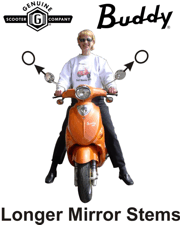
I think this is a great addition to the Genuine Buddy accessories. Those of us who are a touch wide of berth still need to see who/what’s behind us. Yeah, I know, Bev (in the picture) does NOT need longer mirror stems.
…and NO, the new mirror locations are NOT to scale in the picture.
UPDATE
June,2009
The Genuine Buddy 125cc now has an MSRP of $2,699. It has a two-year warranty and two-year roadside assistance. It is available in black, red, orange, seafoam green, light blue & white.

